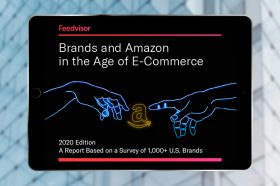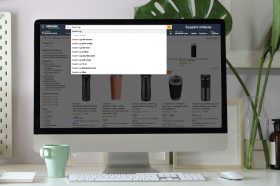Resources - Blog
Amazon PPC and SEO Strategies to Optimize Paid and Organic Search Rank [Webinar Recap]
![Amazon PPC and SEO Strategies to Optimize Paid and Organic Search Rank [Webinar Recap]](https://feedvisor.com/wp-content/uploads/2020/02/ppc-vs-seo-on-amazon-why-you-need-both.jpg)
Stay on top of the latest e-commerce and marketplace trends.
Nearly half of consumers (44%) do not go past the second page of search results on Amazon and 26% frequently buy the first product listed on an Amazon results page.
Certainly, having your product rank highly across both paid and organic search is crucial to your bottom line. Without placement in this coveted digital real estate, you risk losing visibility with your target Amazon audience as well as a decline in sales velocity and relevancy on the marketplace.
Does your Amazon marketing strategy leverage both PPC ads and SEO tactics to enhance discoverability and increase conversions?
In this webinar, AMZ Advisers Co-Founder and Chief Strategist Michael Begg explains the imperative for having both an Amazon PPC and SEO strategy, how PPC ads and SEO tactics differ and how they complement each other to drive sales, and Amazon-specific strategies you can leverage to improve your advertising performance and organic search rank to achieve your overall sales goals.
The Differences Between PPC and SEO on Amazon
SEO stands for “search engine optimization,” which is the process of increasing the quality and quantity of traffic from organic or natural search results on search engines. On Amazon, every product has an ASIN and each ASIN is indexed for certain search terms based on the product listing’s SEO content. This content includes the product title, bullet points, product descriptions, back-end search terms, and subject matter fields.
When a consumer goes to Amazon and enters a search term or keyword into the search field, Amazon populates the most relevant products related to that search term within the search engine results page (SERP).
To increase your product’s organic visibility, you must incorporate keywords into the content of your product detail page, in each of the areas mentioned above. This will help drive sales of your product on that keyword when a customer comes to the search page — or essentially when the product listing makes a conversion on that search term.
Conversely, PPC, which stands for pay-per-click, is a keyword-based auction where sellers bid to place an ad for a specific keyword. On Amazon, the auction is a second-price auction, meaning that you will never have to pay what you actually bid on that keyword but rather you pay 1 cent more than the second highest bid on that keyword.
For example, if you bid $1.50 on a keyword and your competitor bids $1, you will pay $1.01 to beat your competitor’s bid so that your product appears for that keyword or search term. This can be executed manually or automatically:
- Manual PPC campaigns allow advertisers to bid on specific keywords that are relevant to a product with different match types.
- Automatic PPC campaigns place ads based on the SEO content within each listing.
By driving more sales for a specific search term, you can increase your organic visibility through increased conversions on those search terms — all of which is determined by Amazon’s A9 ranking algorithm. Factors that the algorithm considers include:
- Sales History: How long has a product been selling on the Amazon platform?
- Sales Velocity: How many sales has it achieved in that time?
- Conversions: How does this product convert when a shopper reaches its page?
- Pricing: How does the price compare to similar products?
SEO and PPC Best Practices
When getting started on Amazon, there are several best practices around PPC and SEO strategies to keep in mind:
Amazon SEO Best Practices:
- Optimize product titles: Be sure to incorporate two to three keyword search terms and do not exceed Amazon’s character limit.
- Use phrases: Rather than standalone keywords, like “dog” and “bed”, incorporate phrases such as “dog bed” so the A9 algorithm indexes your product on those words used together. Otherwise, if you use separated keywords, the algorithm will pull words together on its own, which could be the wrong combination you are seeking to be indexed for.
- Hierarchy of importance: When optimizing your content for SEO, you should place your keywords in order of importance — beginning with the product title, bullet points, back-end search terms, the subject matter field, and product description.
- Avoid keyword stuffing: Long titles and product descriptions with excessive keywords impact the flow and clarity of your content, ultimately resulting in a poor customer experience.
Amazon PPC Best Practices:
- Use one SKU per auto campaign: Doing this will ensure that your keyword discovery through automatic campaigns is not influenced by a different product having that keyword in the same campaign. Separating these will help you identify the most profitable keywords.
- Use one SKU per ad group in manual campaigns: You do not want to use different SKUs that are at different price points, as this will impact your ACoS and overall campaign management.
- Start bidding high: Always begin bidding higher so you get the impressions in your spend. It is easier to optimize for profitability or other advertising objectives when you have collected data to inform your strategy.
- Utilize phrase and exact match types: This will help increase impressions and drive sales on those keywords, which will ultimately begin to fuel the Amazon flywheel. Learn more about the Amazon flywheel in this article here.
Combining SEO With PPC to Achieve Sales Goals
- Performing proper keyword research and creating strong, SEO-rich content is the basis for success on Amazon.
- Organic sales contribute to your overall profitability — your primary goal should be to maximize organic visibility.
- PPC ads should focus on maximizing the organic visibility of your identified keywords by converting browsers to buyers on Amazon.
- PPC sales should target at least a break-even ACoS or focus on decreasing TACoS over time.
- Aggressive advertising on indexed keywords will increase organic visibility and lead to sales growth multiples.
For the full presentation and explanation of PPC vs. SEO strategies on Amazon, watch the webinar recording here.
Learn what Feedvisor can do for your business.
When you partner with Feedvisor, you automatically receive access to our true, AI-driven technology and hands-on team of e-commerce experts. Contact one of our team members today to learn more about our end-to-end solution for brands and large sellers on Amazon, Walmart, and e-marketplaces.




